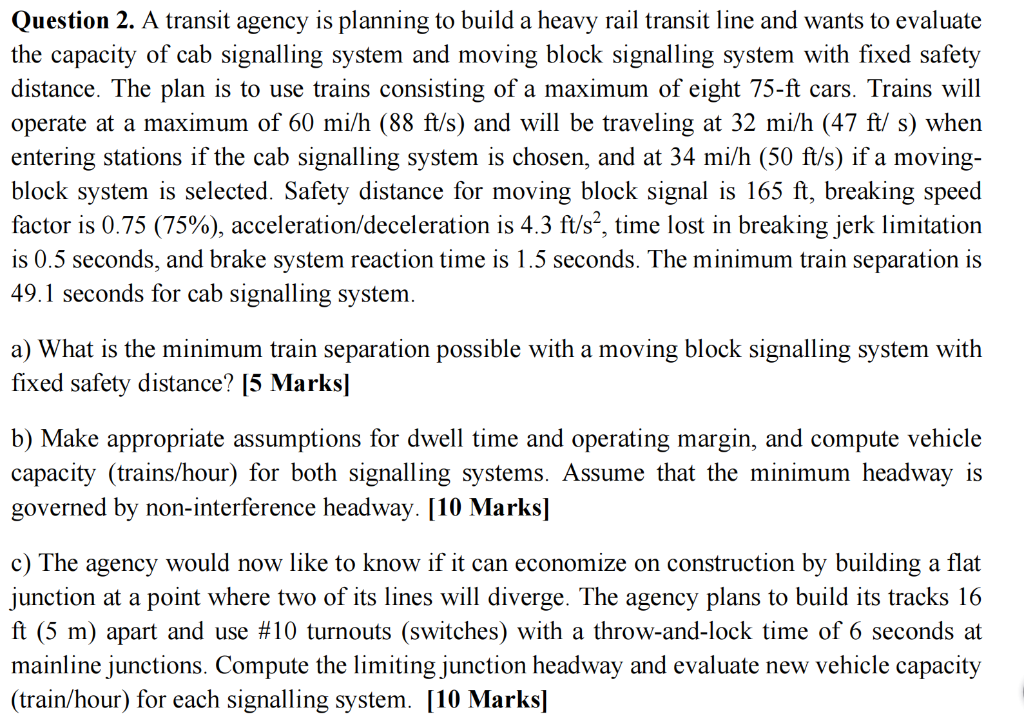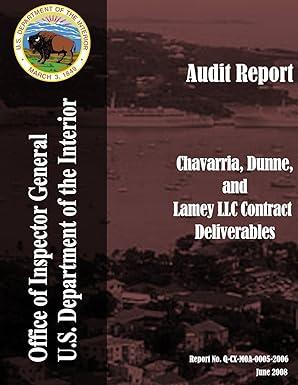
Question 2. A transit agency is planning to build a heavy rail transit line and wants to evaluate the capacity of cab signalling system and moving block signalling system with fixed safety distance. The plan is to use trains consisting of a maximum of eight 75-ft cars. Trains will operate at a maximum of 60 mi/h (88 ft/s) and will be traveling at 32 mi/h (47 ft/ s) when entering stations if the cab signalling system is chosen, and at 34 mi/h (50 ft/s) if a moving- block system is selected. Safety distance for moving block signal is 165 ft, breaking speed factor is 0.75 (75%), acceleration/deceleration is 4.3 ft/s?, time lost in breaking jerk limitation is 0.5 seconds, and brake system reaction time is 1.5 seconds. The minimum train separation is 49.1 seconds for cab signalling system. a) What is the minimum train separation possible with a moving block signalling system with fixed safety distance? [5 Marks] b) Make appropriate assumptions for dwell time and operating margin, and compute vehicle capacity (trains/hour) for both signalling systems. Assume that the minimum headway is governed by non-interference headway. [10 Marks] c) The agency would now like to know if it can economize on construction by building a flat junction at a point where two of its lines will diverge. The agency plans to build its tracks 16 ft (5 m) apart and use #10 turnouts (switches) with a throw-and-lock time of 6 seconds at mainline junctions. Compute the limiting junction headway and evaluate new vehicle capacity (train/hour) for each signalling system. [10 Marks] Question 2. A transit agency is planning to build a heavy rail transit line and wants to evaluate the capacity of cab signalling system and moving block signalling system with fixed safety distance. The plan is to use trains consisting of a maximum of eight 75-ft cars. Trains will operate at a maximum of 60 mi/h (88 ft/s) and will be traveling at 32 mi/h (47 ft/ s) when entering stations if the cab signalling system is chosen, and at 34 mi/h (50 ft/s) if a moving- block system is selected. Safety distance for moving block signal is 165 ft, breaking speed factor is 0.75 (75%), acceleration/deceleration is 4.3 ft/s?, time lost in breaking jerk limitation is 0.5 seconds, and brake system reaction time is 1.5 seconds. The minimum train separation is 49.1 seconds for cab signalling system. a) What is the minimum train separation possible with a moving block signalling system with fixed safety distance? [5 Marks] b) Make appropriate assumptions for dwell time and operating margin, and compute vehicle capacity (trains/hour) for both signalling systems. Assume that the minimum headway is governed by non-interference headway. [10 Marks] c) The agency would now like to know if it can economize on construction by building a flat junction at a point where two of its lines will diverge. The agency plans to build its tracks 16 ft (5 m) apart and use #10 turnouts (switches) with a throw-and-lock time of 6 seconds at mainline junctions. Compute the limiting junction headway and evaluate new vehicle capacity (train/hour) for each signalling system. [10 Marks]







